

|
[I3] Solo Soundclip:
|
[I5] Solo Soundclip:
|
[G2]-[G5] Solo Soundclip:
|
| See Steve's Hand-Written Solo
Transcription |
|
Steve Khan's acoustic guitar solos on: "Island Letter"(Shuggie Otis) Once the supernatural vocalist/arranger Mark Kibble and I had agreed that we would collaborate on an interpretation of Shuggie Otis' song, "Island Letter" from his 1974 album, "INSPIRATION INFORMATION" I had to begin to conceive of way to maintain some of the charm and innocence of the original, while adding touches that would be more personal for Mark and me. 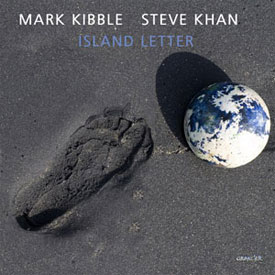 As I have previously noted in my "Island Letter" SAGA, the original version of the song only has 2 verses and then, you could say that this is followed by some 2:30 of what could described as cosmic noodling without any real soloing of substance - and remember, Shuggie was a very fine young blues guitarist - so he certainly could have done that. For what I was going to undertake with Mark Kibble, there needed to be some solo sections for my acoustic guitar, but not so expansive that they would take away from the vocals that were always intended to be the jewel sitting on a satin pillow of harmony and rhythm. As Mark's vocal range is almost limitless, we decided to perform the song in its original key, and that puts the first vamp or Intro interlude as a short 8-bar section that features Emaj7 to Dmaj7, one bar each. That little section reappears in this arrangement between Verse 1 and Verse 2. As I have previously noted in my "Island Letter" SAGA, the original version of the song only has 2 verses and then, you could say that this is followed by some 2:30 of what could described as cosmic noodling without any real soloing of substance - and remember, Shuggie was a very fine young blues guitarist - so he certainly could have done that. For what I was going to undertake with Mark Kibble, there needed to be some solo sections for my acoustic guitar, but not so expansive that they would take away from the vocals that were always intended to be the jewel sitting on a satin pillow of harmony and rhythm. As Mark's vocal range is almost limitless, we decided to perform the song in its original key, and that puts the first vamp or Intro interlude as a short 8-bar section that features Emaj7 to Dmaj7, one bar each. That little section reappears in this arrangement between Verse 1 and Verse 2.The first 8-bar guitar solo section appears in the performance at Letter [I3] @ 1:23. In order to maintain points-of-interest, I decided to take what was once Emaj7 to Dmaj7 convert it to Emaj7 to Am7(9)/D, and this subtle change of chords gives me something a little different to improvise over. In addition to that, there is a radical change of texture. To this point in the arrangement, there has been Rob Mounsey's rich textures from his Rhodes, often joined by Mark Kibble's even richer background vocal tapestries. They become something of wonder - but, it can get very dense. So, my idea was to simply thin things out a bit. When this solo section begins, my Martin MC-28 steel-string acoustic guitar is only supported by the beautiful sustained nature of Rob's pads (often a combination, a sonic sandwich, of strings and woodwinds) and the Cha-cha-cha rhythms supplied by two of the genres most celebrated players: Rubén Rodríguez (5-String Elec. Bass) and Marc Quiñones (Timbal, Conga and Güiro). After 4-bars of this more transparent texture, we are joined by Mark Kibble's inventive backgrounds. So, the foundation is set for the actual playing to begin. If you are looking at the transcription, you might be seeing a lot 16th-notes, giving you the faulty impression that there is a lot "fast" playing going on, but in actuality, that's really far from the truth. You must remember that "Island Letter" is essentially a ballad, a rhythmic ballad, 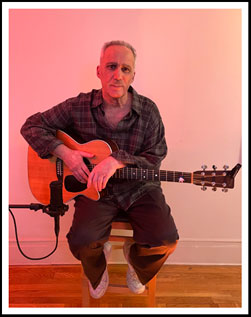 but a ballad nonetheless. Here it is performed at a tempo of Q=100 and throughout the song it alternates between two Latin rhythms, the Bolero and the aforementioned Cha-cha-cha. After some thought, and only in retrospect, by instinct, I was playing with a double-time feel against the very insistent and precise Cha-cha rhythms. This is why you see so many 16th-notes or 16th-note sub-divisions. So, keep this in mind as you are listening and following along. For me, theoretically speaking, taken as whole, I see this movement between Emaj7 and Am7(9)/D as moving back and forth in way that reflects the Am7 chord as if it is a plagal cadence - in other words Imaj-iv7-Imaj - taken this way, what happens makes complete musical sense. If I was to isolate each sonority, I would see the Emaj7 chord breaking down to the E Ionian mode [E, F#, G#, A, B, C#, D#] more that E Lydian, where the inclusion of A# would occur. I only see one A# during the whole solo and that happens in Bar 7. Over the Am7(9)/D, I see this simply as A Dorian [A, B, C, D, E, F#, G]. Between these two modes, if you are looking for common tones, you would find 4 of them: E, F#, A and B. but a ballad nonetheless. Here it is performed at a tempo of Q=100 and throughout the song it alternates between two Latin rhythms, the Bolero and the aforementioned Cha-cha-cha. After some thought, and only in retrospect, by instinct, I was playing with a double-time feel against the very insistent and precise Cha-cha rhythms. This is why you see so many 16th-notes or 16th-note sub-divisions. So, keep this in mind as you are listening and following along. For me, theoretically speaking, taken as whole, I see this movement between Emaj7 and Am7(9)/D as moving back and forth in way that reflects the Am7 chord as if it is a plagal cadence - in other words Imaj-iv7-Imaj - taken this way, what happens makes complete musical sense. If I was to isolate each sonority, I would see the Emaj7 chord breaking down to the E Ionian mode [E, F#, G#, A, B, C#, D#] more that E Lydian, where the inclusion of A# would occur. I only see one A# during the whole solo and that happens in Bar 7. Over the Am7(9)/D, I see this simply as A Dorian [A, B, C, D, E, F#, G]. Between these two modes, if you are looking for common tones, you would find 4 of them: E, F#, A and B.The pick-up to this solo piece in [I3] descends within an arpeggio born of B7(b5b9) and spelling down you have: B-A-F-C-A all eventually resolving to B-natural as the Emaj7 appears. On beat 3, there is a nice color tone, F#(9th). Then there is a pick-up into the Am9/D chord which observes all of the notes from A Dorian. It's important to note the little Jazz phrasing ornament at the end of beat 1. A small gesture like that conveys so much more about where the player comes from than all of the other notes combined. Notice how the end of phrase is an interval of a 4th (F#-B) and in bar 3 that interval is picked-up and becomes G#-C# and that ends-up becoming C#-F#. These phrases provide an intervallic continuity to the solo. In bar 4, once again, the A Dorian mode is mostly there and notice how you have the notes A-B-C resolving to B-natural again on beat 1 of bar 5 as the Emaj7 chord arrives. Within this bar you see more 4ths: D#-G# and eventually F#-B. You could say that this passage is derived from G# minor pentatonic [G#, B, C#, D#, F#] which gives you lots of the color tones: 6th(C#), maj7th(D#) and the 9th(F#). In bar 6, we have the first appearance of a bent note, B-natural up to C over Am9/D. There is a pentatonic feeling to the phrases in bar 6 but I don't know that I would say that these notes are specifically coming from B minor pentatonic [B, D, E, F#, A] because you don't see/hear a D-natural in this line. In bar 7, even though we are playing over an Emaj7 sonority, the blues language enters because of the G-natural against the G#'s. As I mentioned before, this bar provides the only glimpse of D# minor pentatonic [D#(maj7), F#(9th), G#, A#(#4), C#(6th)] which gives you the #4 sound within and that sense of the Lydian mode. Not matter what, you are producing all of the color tones. in bar 8, this feels like I am using the E minor pentatonic [E, G, A, B, D], but on beat 3 you hear the returning sense of Jazz chromaticism, and on beat 4, you can see that I am anticipating the coming chord for the next vocal section, Abmaj7, by putting to use C minor pentatonic [C, Eb, F, G, Bb] which gives me some beautiful color tones leading to a resolution on the note, C-natural, the 3rd of Abmaj7. This also happens to be the 1st note of the melody that Mark Kibble is to sing. The solo piece in [I5] again appears between the two verses, but this time it is after a modulation taking the piece up 1/2-step so that Mark Kibble's vocals are sung over Amaj7. Observing that, the chords for the solo have now become: Fmaj7 to Bbm7(9)/Eb, and this section during the full version appears at 3:37. Before the solo begins, you hear a break where Mark Kibble, Rob and I play a beautiful C7(#9#5) sonority, so the pick-up to solo begins on that same #5, here spelled as Ab(G#), and includes the b9(Db) along with F-natural, the root of the chord to which we are headed. In the bar 1, you hear lots of color tones and more intervals with 4ths appearing. But it also begins a series of rhythmic motifs with syncopated 16th-notes. You can hear on timbal that Marc Quiñones chose to accent the last of those 16th-notes in both bars 1 & 2. It's a really nice touch by a great musician. 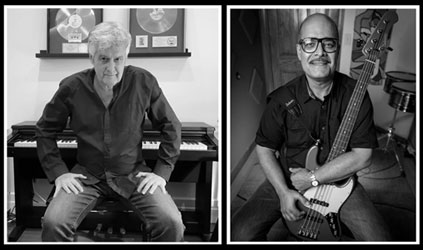 In bar 1 the phrase ended with this sequence of notes: A-D-E-F and in bar 2, now over Bbm7/Eb, they become Ab-Db-Eb-Ab - notice that they are 1/2-step down from the prior bar. When the chord returns to Fmaj7, those notes go back up a 1/2-step which maintains a sense of development and continuity in the solo. Over these two chords, I see that I am putting to use A minor pentatonic [A, C, D, E, G] over Fmaj7 and Bb minor pentatonic [Bb, Db, Eb, F, Ab]. You can see/hear that those two pentatonic choices are 1/2-step away from one another. In bar 3, on beat 3-4, I actually pass through using D minor pentatonic [D, F, G, A, C], something that I rarely do over maj7 chord because of the presence of the root(F). In bar 4, with the chord change shifting to Bbm7/Eb, my linear approach changes to using F minor pentatonic [F, Ab, Bb, C, Eb] over the sonority. In bar 5, over the Fmaj7 chord, the approach becomes a bit more modal, more linear using F Ionian [F, G, A, Bb, C, D, E] though I avoid touching upon the 4th(Bb). Notice that when I hit the maj3rd(A-natural), I again use the chromatic lower neighbor(G#) as a bluesy touch, just as I did in [I3] in bar 7. Again, these little details give a sense of continuity to the soloing as a whole. In bar 6, over Bbm7/Eb, the sense of the blues is in full display, especially on beats 3-4. Notice the blue-note of E-natural, used as a grace note. When the Fmaj7 chord returns, the same intervallic shapes reappear: C-F-G taking us up to an Ab as the Bbm7/Eb chord arrives in bar 8. To close this brief 8-bar solo section, I have to transition to the arriving Amaj7 chord, remember we have modulated earlier, and to observe it, this time the intervals become: C#(3rd)-E-natural(5th)-B-natural(9th), giving Mark Kibble a space and nice way to pick-up into his first note which is now a C#. In bar 1 the phrase ended with this sequence of notes: A-D-E-F and in bar 2, now over Bbm7/Eb, they become Ab-Db-Eb-Ab - notice that they are 1/2-step down from the prior bar. When the chord returns to Fmaj7, those notes go back up a 1/2-step which maintains a sense of development and continuity in the solo. Over these two chords, I see that I am putting to use A minor pentatonic [A, C, D, E, G] over Fmaj7 and Bb minor pentatonic [Bb, Db, Eb, F, Ab]. You can see/hear that those two pentatonic choices are 1/2-step away from one another. In bar 3, on beat 3-4, I actually pass through using D minor pentatonic [D, F, G, A, C], something that I rarely do over maj7 chord because of the presence of the root(F). In bar 4, with the chord change shifting to Bbm7/Eb, my linear approach changes to using F minor pentatonic [F, Ab, Bb, C, Eb] over the sonority. In bar 5, over the Fmaj7 chord, the approach becomes a bit more modal, more linear using F Ionian [F, G, A, Bb, C, D, E] though I avoid touching upon the 4th(Bb). Notice that when I hit the maj3rd(A-natural), I again use the chromatic lower neighbor(G#) as a bluesy touch, just as I did in [I3] in bar 7. Again, these little details give a sense of continuity to the soloing as a whole. In bar 6, over Bbm7/Eb, the sense of the blues is in full display, especially on beats 3-4. Notice the blue-note of E-natural, used as a grace note. When the Fmaj7 chord returns, the same intervallic shapes reappear: C-F-G taking us up to an Ab as the Bbm7/Eb chord arrives in bar 8. To close this brief 8-bar solo section, I have to transition to the arriving Amaj7 chord, remember we have modulated earlier, and to observe it, this time the intervals become: C#(3rd)-E-natural(5th)-B-natural(9th), giving Mark Kibble a space and nice way to pick-up into his first note which is now a C#.After the song has moved through [E] and [E2], the 2nd-half of the 2nd verse in the new key, we arrive at Letter [F], which is our 16-bar vocal breakdown feature for the unending imagination of Mark Kibble where he accompanied only by Marc Quiñones' conga and güiro along with a simple kick drum and foot-hat. When Mark's beautiful improvised cadence brings back Rubén's bass, we move into the Outro, Letter [G] through [G5] which brings together all of the elements from the piece and was always intended to be a long acoustic guitar solo - which it is. But make no mistake, there is a LOT going on even though each 8-bar section brings in new elements of the accompaniment. Where the soloing is concerned, we have modulated again and this new section features Shuggie's original chord movement except now we going from Cmaj7 down a whole-step to Bbmaj7, one bar each for 6 bars, and then a little surprise of an Amaj7(9) chord for bars 7-8. A simple chord progression like this offers plenty of room for creative improvising. When [G] arrives, it was my initial thought that, because Mark was just emerging from a vocal extravaganza, he should be allowed to continue for 6 bars with some vocal ad libs. In order to provide some contrast from the guitar, I added in some Ralph Towner-esque harmonics splashes which add a unique touch. Finally, in bars 7-8 over the Amaj7 chord, the acoustic guitar begins to solo in earnest. One of the nice things about recording this way, via remote, is that the guitar parts were all done beforehand, and it seems that what I played in bars 7-8 had some influence on Mark Kibble's fantastic melisma in those same bars. 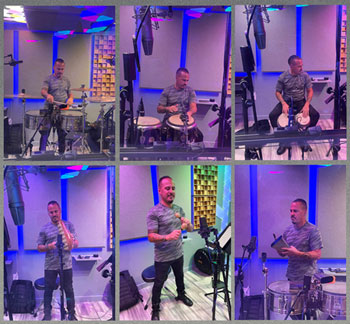 Mark also had the brilliant idea of moving his vocal improvs off to one side so as not to be competing with guitar solo. Engineer Malcolm Pollack and I decided to move that vocal track off to the right side between 2 and 3 o'clock if you knob/dial works that way. This one small detail allows these two important elements to speak through all of the instruments with a degree of greater clarity. Mark also had the brilliant idea of moving his vocal improvs off to one side so as not to be competing with guitar solo. Engineer Malcolm Pollack and I decided to move that vocal track off to the right side between 2 and 3 o'clock if you knob/dial works that way. This one small detail allows these two important elements to speak through all of the instruments with a degree of greater clarity.When the solo really begins at [G2], during the first 3 bars, I am really paraphrasing the first line of the melody Mark sings, "How did you think of me....." In bar 4, over the Bbmaj7 chord I am employing D minor pentatonic [D, F, G(6th), A(maj7th), C(9th)], a favorite device of mine because the minor pentatonic built upon the 3rd of a major chord gives you 3 of the beautiful color tones. Though it might be a detail that goes by unnoticed, I wrote into the arrangement, into Rob's Rhodes part on beats 3-4 in bar 4 of each go 'round from [G2] to [G5]. [If you are really curious, visit the "SAGA" page and look at the Keyboard Lead Sheets, Pg. 6] As a special touch, I isolated those same harmonic moments and had Mark Kibble pay special vocal attention to them. He's one of the few singers who could hear such things and be fearless about them. The inspiration for these little 2-beat adventures comes from listening to Chick Corea's comping during the mid-'60s on albums like Cal Tjader's "SOUL BURST." The theoretical idea is that you are implying a sense of G7(altered) over the Bbmaj7 chord even if no one else is observing this same harmonic feeling. In bars 5-6, though I am only spelling out parts of the basic triad over Cmaj7, that is answered by a similar rhythmic motif but I play the maj7th(A) instead of the root. Then, on beats 3 & 4, the D minor pentatonic reappears. When the Amaj7 chord arrives for bars 7-8, I am now using G# minor pentatonic [G#(maj7th), B(9th), C#, D#(#4), F#(6th)] which produces all of the color tones, including the #4 which gives you that Lydian mode feeling. For me, this is especially effective when that tone is not placed on beat that calls special attention to it. In bar 8, while still using those same notes, notice how I am bringing a more bluesy feeling to everything even though I'm playing over a major 7th chord. | Cmaj7 / / / | Bbmaj7 / / / | Amaj7(9#4) / / / | / / / / :|| With the arrival of [G3] and the intensity building from the players and the vocals, once again a rhythmic motif becomes a key element as in bar 1 over the Cmaj7 chord, I am using the now familiar device of E minor pentatonic [E,G, A, B, D] and as the Bbmaj7 chord arrives, I am simply going down a whole-step. In bar 3, the approach is similar to bar 1 in terms of the note choices. However, in bar 4, this time I observe the implied harmony below and here I am playing notes from the G altered dominant scale [G, Ab(b9), Bb(#9), B, Db(b5), Eb(#5), F] which gives me all of the altered tones. Remember, I am playing this line over a Bbmaj7 but implying the sense of V7(alt.) chord headed towards Cmaj7. If you like the way this sounds, now you know how you can employ such things yourself. In bars 5-6, the sense of rhythmic motifs and continuity continue, but this time, on beat 3-4 of bar 6, 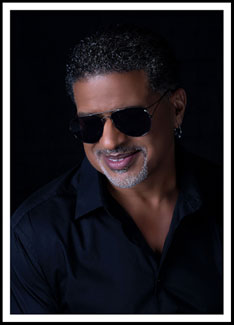 over the Bbmaj7 chord, there is some chromatic Jazz phrasing which broadens the liner scope. In bars 7-8, a most familiar rhythmic grouping appears which unconsciously now reminds me of my own tune "Descarga Khanalonious" from "CROSSINGS" or Michael Brecker's "Song for Barry." Amazing how these things from the past creep into your playing now and again. The descending line in bar 8 is a rather classic Jazz configuration over major 7th chords beginning on the 9th with a familiar phrasing mannerism of a little triplet figure leading into the line. over the Bbmaj7 chord, there is some chromatic Jazz phrasing which broadens the liner scope. In bars 7-8, a most familiar rhythmic grouping appears which unconsciously now reminds me of my own tune "Descarga Khanalonious" from "CROSSINGS" or Michael Brecker's "Song for Barry." Amazing how these things from the past creep into your playing now and again. The descending line in bar 8 is a rather classic Jazz configuration over major 7th chords beginning on the 9th with a familiar phrasing mannerism of a little triplet figure leading into the line.As [G4] begins, there is a noticeable increase in the flow of the notes, meaning more of them - more 16th-note activity. Now with a bit more usage of chromaticism while still putting to use the same pentatonic ideas of Cmaj7 to Bbmaj7. In bar 2, there's an idea that I like very much in hindsight as you see the little chromatic pick-up into the bar, and then, on the and of beat 2, there is the same chromatic pick-up into beat 3 but this time, I am really using F Dorian [F,G, Ab, Bb, C, D, Eb] as a kind of plagal cadence to lead me back to Cmaj7 - again without anyone else observing what I have done because it just goes by too quickly. What I also like is that in bar 3, even though we have now arrived at Cmaj7, on beat 3, you see that I am still putting to use that sense of F minor, notice how Ab and F surround the G-natural. This time in bar 4, something different and interesting takes place. On beats 1-2, over the Bbmaj7, I am actually playing C minor pentatonic [C, Eb, F, G, Bb] which might seem strange because of the appearance of both the Root(Bb) and the Sus(Eb) over a maj7th chord. But, in the context of thematic devices, it all makes sense because this is followed by my using a fragment of Db dominant 7th pentatonic [D, Eb, F, Ab, Cb] over that ever-so-brief moment offering the sense of G7(alt.). In bars 5-6, the density of the note activity continues but in bar 6 I am using a bluesy device over the Bbmaj7 chord by playing a blues idea still connected to the Cmaj7 chord but the blues is coming from A minor pentatonic [A, C, D, E, G] with the inclusion of an Eb the blue note which gives the line so much flavor and feeling. In bar 7, over the Amaj7(#4) chord, once again, there is a connection to the triad-like ideas that arrived in bar 1 and 5 of this section, but mostly you are hearing G# minor pentatonic again with more of a sense of chromaticism - all contributing to the Jazzy nature of this kind of soloing. Bar 8 concludes with more bluesy phrasing and a gently bent-up note on the B-natural which here is the 3rd of G# minor pentatonic. Again, a bluesy nuance over a major 7th chord. At [G5], the performance is beginning to fade out, but the bluesy nature of the soloing only grows. Notice the double-stop blues mannerism with G-natural on top and the grease into the D-natural, the 3rd of Bbmaj7 as the phrase comes to an end on Ab - the b7 which is obviously not in the chord - but one can and should be able to hear such things without feeling that you are forcing them into the context. In bar 3, there is still that sense of E minor pentatonic over the Cmaj7 chord. And once again, in our special bar 4, on beats 1-2 the blues is there again with the Eb blue note (from the C chord) over Bbmaj7, but this time, on beats 3-4, I am playing a bluesy idea based upon Bb minor pentatonic [Bb(#9), Db(b5), Eb(#5), F, Ab(b9)] though imagining that it is actually over a G7(altered) chord. Here the presence of the G-natural on the 2nd 16-note of beat 3 gives the line a really special flavor and character. With the solo driving home now, in bars 5 and 6, I almost hear myself referring to Wes Montgomery's "Four on Six" only here the line configuration is applied to Cmaj7 and Bbmaj7. In bars 7-8, over the Amaj7 chord, the phrasing is again very much blues derived and tip of the cap to the great, great Albert King. By this point in time, these phrases are barely audible, but they ARE there!!! I hope that reading what I've written here, listening to the soundclips and following along with the transcription will help to demystify everything. After the May 13th, 2022 release of "Island Letter" via Joseph Patrick Moore's Blue Canoe Records, I have received so many wonderful messages and e-mails about this piece, and more specifically about the guitar soloing that, sharing these transcriptions seemed like the best possible thing to do. I'm hopeful that those who have written to me will find these new pages and will take full advantage of everything that I have shared here. As some of you may know, I did a really crazy thing, against all the sage advice that I was given by close friends and colleagues alike, and my own knowledge of the state of the record business - AND, worst of all, that, in essence, NO ONE owns a CD player any longer, much less a real stereo system. And, of course, computers no longer come with disc drives, cars don't have CD players, etc.!!! What does one do? Well, I had some special "COLLECTOR'S EDITION" CDs manufactured of "Island Letter" and Blue Canoe Records has made them available via their site. Just click on the link if you're interested, and you'll be there!!! In addition to the options of CDs, of course, the now more traditional option of owning the music via iTunes is also available to you. Please support the music of all artists by making these kinds of simple purchases - a small gestures like that is what will keep the music you love the most coming to you from the artists, small and large, that you care about the most. It really does mean a lot in the bigger picture. "THANK YOU SO MUCH!!!" As it is now late May of 2022, I had been hopeful that, perhaps, we, most of the world over, were finally seeing a slow path to the return of a new form of normal! It was a bit hard to say what that was going to look like, as things still don't feel exactly normal here in New York City - that's for certain. But, just as I was beginning to feel that there was a sense that the worst of COVID and its variants might be behind us, suddenly now I feel that this is not the case at all! As here in the northeast, we are experiencing yet another spike in cases. Even though I just had my 2nd Moderna Booster shot, I don't feel any the safer than I did before it. What a mess this is! And while that situation is right in front of us all, we have a brutal and completely unjustified war raging in Ukraine with no end in sight. The global impact of this Putin madness is being felt everywhere. At least, this war has caused a new strengthening of NATO and a rekindled banding together of nations. In Buffalo, we just had another racially motivated and senseless mass shooting - and, as it always is here, there will be lots of screaming and shouting and protests, etc. - and those bastards in Washington, DC will do NOTHING to curb the sale of weapons! Or at the very least, to curb the sale of weapons to people who should never have them. I have no hope that anything is ever going to change, no matter how great the tragedy might be. What is it going to take? That remains a question that gets asked over and over, and over again! And just as I had written the above, we experienced yet another Elementary School Mass Shooting in Uvalde, Texas on Tuesday, May 24th. Again, WHAT is it going to take? How many more school shootings where innocent children lose their lives over nothing - and our government does NOTHING to make this stop!!! Then, by some miracle, we, as a nation, somehow survived, 4 years of a government that was a whisker away from becoming an autocracy. I think that we have been warned, and now we know that, "IT CAN HAPPEN HERE!" So, let's take care of one another, of our country, and once again, continue to be a participant with the rest of the world - or most of it - making everything a little better globally - step-by-step, and day-by-day. Wishing anyone and everyone who might be reading this continued GOOD HEALTH and SAFETY - and some sense of inner PEACE!
[Photos: Steve Khan by Simon Berg
Rob Mounsey by Paul Mounsey Rubén Rodríguez by Carlitos Padrón Marc Quiñones by Néstor Rigaud Mark Kibble by Tonya Osborne] |